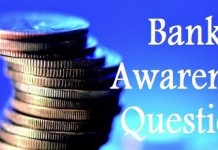Hello Aspirants,
Welcome to Banking Awareness Quiz in AffairsCloud.com. Here we are creating quiz covering important questions which are common for all the bank exams and other competitive exams.
- A trad-able form of loan is normally termed as ________
A. Certificate of Deposit (CD)
B. Inter Bank term Money
C. Bill Re-discounting
D. Debt Instrument
E. None of the AboveD. Debt Instrument
Explanation:
A trad-able form of loan is normally termed as a Debt Instrument. They are usually obligations of issuer of such instrument as regards certain future cash flow representing Interest & Principal, which the issuer would pay to the legal owner of the Instrument. - Which of the following is not a type of Debt Instrument?
A. Issuer class
B. Security
C. Coupon bearing
D. All of the Above
E. None of the AboveE. None of the Above
Explanation:
Debt Instruments are of various types.The distinguishing factors of the Debt Instruments are as follows:
Issuer class
Coupon bearing / Discounted
Interest Terms
Repayment Terms
Security / Collateral / Guarantee - Debentures are divided into different categories on the basis of which of the following?
A. Convertibility
B. Security
C. Term
D. Both (A) and (B)
E. None of the AboveD. Both (A) and (B)
Explanation:
Debentures are divided into different categories on the basis of: convertibility of the instrument and Security.
Debentures can be classified on the basis of convertibility into:
Non Convertible Debentures (NCD)
Partly Convertible Debentures (PCD)
Fully convertible Debentures (FCD)
Optionally Convertible Debentures (OCD)
Debentures can be classified on the basis of security into:
Secured Debentures
Unsecured Debentures - Which of the following instruments retain the debt character and can not be converted in to equity shares?
A. Non Convertible Debentures (NCD)
B. Partly Convertible Debentures (PCD)
C. Fully convertible Debentures (FCD)
D. Optionally Convertible Debentures (OCD)
E. None of the AboveA. Non Convertible Debentures (NCD)
Explanation:
Non Convertible Debentures instruments retain the debt character and can not be converted in to equity shares. - In which of the following instruments the investor has the option to either convert these debentures into shares at price decided by the issuer/agreed upon at the time of issue.
A. Non Convertible Debentures (NCD)
B. Partly Convertible Debentures (PCD)
C. Fully convertible Debentures (FCD)
D. Optionally Convertible Debentures (OCD)
E. None of the AboveD. Optionally Convertible Debentures (OCD)
Explanation:
The investor has the option to either convert these debentures into shares at price decided by the issuer/agreed upon at the time of issue. - In which of the following conversion the investors enjoy the same status as ordinary shareholders of the company?
A. Secured Debentures
B. Partly Convertible Debentures (PCD)
C. Fully convertible Debentures (FCD)
D. Optionally Convertible Debentures (OCD)
E. Unsecured DebenturesC. Fully convertible Debentures (FCD)
Explanation:
These are fully convertible into Equity shares at the issuer’s notice. The ratio of conversion is decided by the issuer. Upon conversion the investors enjoy the same status as ordinary shareholders of the company. - Under ______ debentures, if the issuer fails on payment of either the principal or interest amount, his assets can be sold to repay the liability to the investors
A. Secured Debentures
B. Partly Convertible Debentures (PCD)
C. Fully convertible Debentures (FCD)
D. Optionally Convertible Debentures (OCD)
E. Unsecured DebenturesA. Secured Debentures
Explanation:
These instruments are secured by a charge on the fixed assets of the issuer company. So if the issuer fails on payment of either the principal or interest amount, his assets can be sold to repay the liability to the investors. - A part of debt instruments that are converted into Equity shares in the future at notice of the issuer is called _________
A. Secured Debentures
B. Partly Convertible Debentures (PCD)
C. Fully convertible Debentures (FCD)
D. Optionally Convertible Debentures (OCD)
E. Unsecured DebenturesB. Partly Convertible Debentures (PCD)
Explanation:
A part of these instruments are converted into Equity shares in the future at notice of the issuer. The issuer decides the ratio for conversion. This is normally decided at the time of subscription. - Who among the following are institutional investors in the Indian Debt Market?
A. Banks
B. Mutual funds
C. Foreign investors (FIIs)
D. Trusts
E. All of the AboveE. All of the Above
Explanation:
Institutional investors operating in the Indian Debt Market are :
Banks
Insurance companies
Provident funds
Mutual funds
Trusts
Corporate treasuries - Who among the following regulates the Indian Corporate Debt Market?
A. RBI
B. NABARD
C. SIDBI
D. SEBI
E. None of the AboveD. SEBI
Explanation:
Regulator for the Indian Corporate Debt Market is the Securities and Exchange Board of India (SEBI). SEBI controls bond market and corporate debt market in cases where entities raise money from public through public issues.
AffairsCloud Recommends Oliveboard Mock Test
AffairsCloud Ebook - Support Us to Grow
Govt Jobs by Category
Bank Jobs Notification


